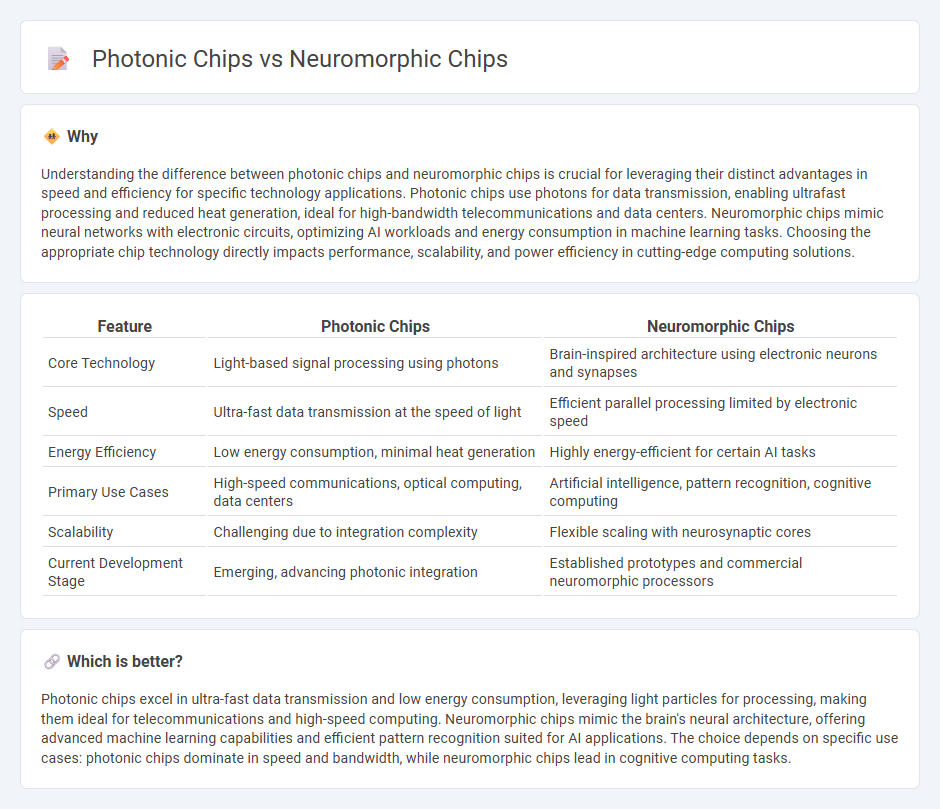
Photonic chips leverage light particles to process information at incredibly high speeds with minimal heat generation, making them ideal for telecommunications and data centers. Neuromorphic chips mimic the human brain's neural architecture, enabling advanced machine learning and energy-efficient cognitive computing. Explore the latest advancements and applications of photonic and neuromorphic chip technologies to understand their impact on the future of computing.
Why it is important
Understanding the difference between photonic chips and neuromorphic chips is crucial for leveraging their distinct advantages in speed and efficiency for specific technology applications. Photonic chips use photons for data transmission, enabling ultrafast processing and reduced heat generation, ideal for high-bandwidth telecommunications and data centers. Neuromorphic chips mimic neural networks with electronic circuits, optimizing AI workloads and energy consumption in machine learning tasks. Choosing the appropriate chip technology directly impacts performance, scalability, and power efficiency in cutting-edge computing solutions.
Comparison Table
| Feature | Photonic Chips | Neuromorphic Chips |
|---|---|---|
| Core Technology | Light-based signal processing using photons | Brain-inspired architecture using electronic neurons and synapses |
| Speed | Ultra-fast data transmission at the speed of light | Efficient parallel processing limited by electronic speed |
| Energy Efficiency | Low energy consumption, minimal heat generation | Highly energy-efficient for certain AI tasks |
| Primary Use Cases | High-speed communications, optical computing, data centers | Artificial intelligence, pattern recognition, cognitive computing |
| Scalability | Challenging due to integration complexity | Flexible scaling with neurosynaptic cores |
| Current Development Stage | Emerging, advancing photonic integration | Established prototypes and commercial neuromorphic processors |
Which is better?
Photonic chips excel in ultra-fast data transmission and low energy consumption, leveraging light particles for processing, making them ideal for telecommunications and high-speed computing. Neuromorphic chips mimic the brain's neural architecture, offering advanced machine learning capabilities and efficient pattern recognition suited for AI applications. The choice depends on specific use cases: photonic chips dominate in speed and bandwidth, while neuromorphic chips lead in cognitive computing tasks.
Connection
Photonic chips utilize light-based signals to process data at ultra-high speeds, while neuromorphic chips mimic neural architectures to enhance computational efficiency. The integration of photonic technology in neuromorphic chips enables faster signal transmission and reduced energy consumption by leveraging optical interconnects. This synergy accelerates advancements in artificial intelligence and machine learning by combining the speed of photonics with the adaptive capabilities of neuromorphic computing.
Key Terms
Spiking Neural Networks
Neuromorphic chips emulate the brain's architecture using spiking neural networks (SNNs) to achieve event-driven computation with low power consumption, ideal for real-time sensory processing. Photonic chips utilize light-based circuits to implement SNNs, offering ultrafast data transmission and reduced latency compared to electronic counterparts. Explore the advancements in spiking neural networks through neuromorphic and photonic technologies for cutting-edge AI applications.
Optical Interconnects
Neuromorphic chips leverage spike-based neural architectures to mimic brain-like processing, while photonic chips utilize light for high-speed data transmission, significantly reducing latency and energy consumption in optical interconnects. Optical interconnects in photonic chips offer ultra-broad bandwidth and minimal crosstalk, making them ideal for scaling computing systems that demand rapid parallel communication. Explore the latest advances in these technologies to understand their impact on next-generation computing.
Energy Efficiency
Neuromorphic chips emulate neural networks on hardware, drastically reducing energy consumption by mimicking brain-like processes, typically achieving efficiency improvements of up to 1,000 times over traditional CPUs. Photonic chips leverage light-based data transmission to minimize heat generation and enable high-speed, low-energy communication, excelling in bandwidth and latency-sensitive applications. Explore detailed comparisons of energy efficiency metrics and real-world implementations to understand which technology leads in sustainable computing.
Source and External Links
What Is Neuromorphic Computing? - Neuromorphic computing is an approach that mimics the human brain by using silicon-based CMOS technology, memristors, and spiking neural networks to integrate memory and data processing, with notable chips including Intel's Loihi and IBM's TrueNorth.
Neuromorphic computing - Wikipedia - Neuromorphic computing uses brain-inspired hardware designs like Neurogrid to emulate neural elements for energy-efficient spiking throughput and supports projects like the Human Brain Project to simulate brains and develop neuromorphic technologies.
Intel unveils largest-ever AI 'neuromorphic computer' that mimics the human brain - Intel's neuromorphic computers like Hala Point employ spiking neural networks to process information through discrete electrical signals, enabling highly parallel computing and integrated memory-computation power, performing significantly faster than conventional architectures.
 dowidth.com
dowidth.com